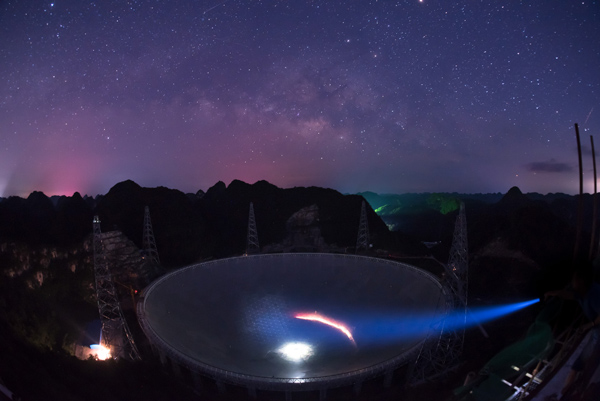No aliens found yet, but 'heartbeats' in universe heard


The world's largest radio telescope is located deep in Southwest China's Guizhou province
One is rapid and strong, and the other is slow and weak, like the heartbeats of a youth and an old man passing through a distance of thousands of light years, and then heard by the most sensitive "ear" on Earth.
The "ear" is the Five-hundred-meter Aperture Spherical Telescope (FAST), the world's largest radio telescope, with a dish as large as 30 football fields. It is located in a valley deep in Southwest China's mountainous Guizhou province.
During the debugging and trial of the telescope since its completion in September 2016, FAST has detected dozens of pulsar candidates, nine of them confirmed by telescopes in other countries. Chinese scientists produced a sound effect of the first two confirmed pulsars based on the observed signals, enabling ordinary people to hear the "heartbeats" deep in the universe.
The objectives of FAST include searching for pulsars, neutral hydrogen, interstellar molecules and signals from the extraterrestrial life.
"Looking for aliens is one of the goals of FAST. But we haven't started that kind of search during the debugging and trial period," says Li Di, chief scientist of the Radio Astronomy Division of the National Astronomical Observatories (NAO) under the Chinese Academy of Sciences (CAS).
However, the pulsars discovered by FAST are an enigma enough. When the first pulsar was discovered in 1967, it was mistaken for a signal from aliens.
Strange pulsars
A pulsar is a highly magnetized, rotating neutron star, which emits two beams of electromagnetic radiation. This radiation can be observed only when the beam of emission is pointing at Earth, in much the same way as a lighthouse can be seen only when the light is pointed at an observer.
A neutron star is the collapsed core of a large star. Neutron stars are the smallest and densest stars known to exist. A neutron star is so dense that one teaspoon of its material would have the mass of a mountain over 3,000 meters high on Earth.
"There are many strange phenomena and natures of pulsars that we don't understand," says Chen Xuelei, a researcher with NAO, adding that scientists have discovered some millisecond pulsars spinning very fast. "More study is needed to find out why they rotate so fast."
With their super strong gravitational and electromagnetic fields and high density, pulsars are regarded as natural laboratories of extreme physical conditions, Chen says.
"If we could find a binary star system composed of a pulsar and a black hole, we would be able to study the space-time around the black hole by using the pulsar," Chen says.
Pulsars can help scientists study gravitational waves. FAST will help improve the chances of detecting low frequency gravitational waves, says Wu Xiangping, a CAS academician, predicting great breakthroughs in this area in the years ahead.
Pulsars have very precise intervals between pulses that range from milliseconds to seconds. They are regarded as the most accurate astronomical clock in the universe. Scientists believe they can use pulsars as "lighthouses" to help navigation in future interplanetary or interstellar travel.




































